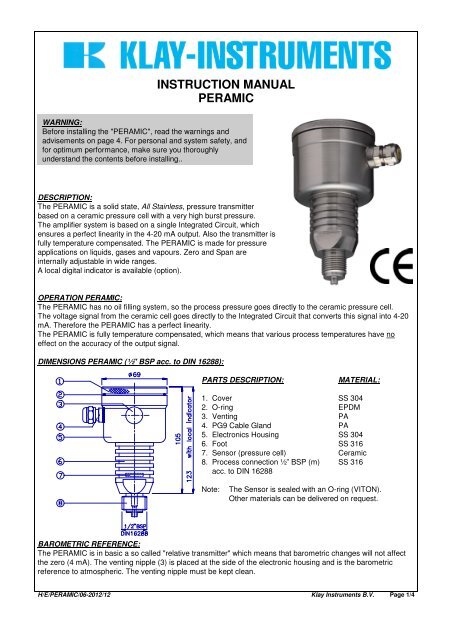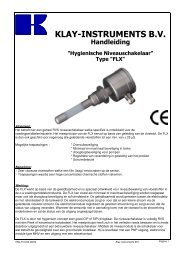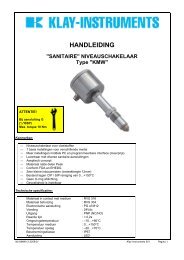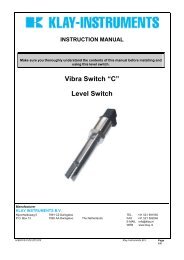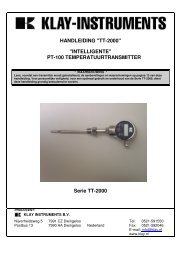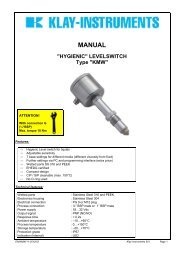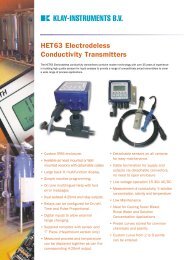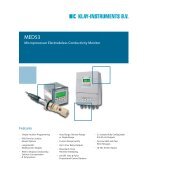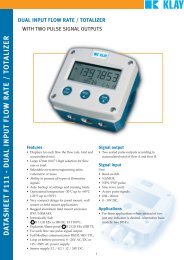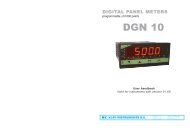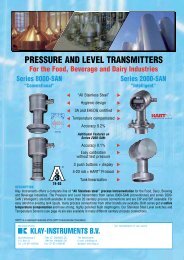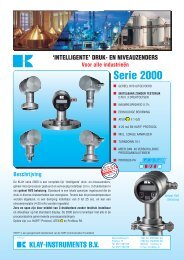INSTRUCTION MANUAL PERAMIC - Klay Instruments
INSTRUCTION MANUAL PERAMIC - Klay Instruments
INSTRUCTION MANUAL PERAMIC - Klay Instruments
You also want an ePaper? Increase the reach of your titles
YUMPU automatically turns print PDFs into web optimized ePapers that Google loves.
<strong>INSTRUCTION</strong> <strong>MANUAL</strong><br />
<strong>PERAMIC</strong><br />
WARNING:<br />
Before installing the "<strong>PERAMIC</strong>", read the warnings and<br />
advisements on page 4. For personal and system safety, and<br />
for optimum performance, make sure you thoroughly<br />
understand the contents before installing..<br />
DESCRIPTION:<br />
The <strong>PERAMIC</strong> is a solid state, All Stainless, pressure transmitter<br />
based on a ceramic pressure cell with a very high burst pressure.<br />
The amplifier system is based on a single Integrated Circuit, which<br />
ensures a perfect linearity in the 4-20 mA output. Also the transmitter is<br />
fully temperature compensated. The <strong>PERAMIC</strong> is made for pressure<br />
applications on liquids, gases and vapours. Zero and Span are<br />
internally adjustable in wide ranges.<br />
A local digital indicator is available (option).<br />
OPERATION <strong>PERAMIC</strong>:<br />
The <strong>PERAMIC</strong> has no oil filling system, so the process pressure goes directly to the ceramic pressure cell.<br />
The voltage signal from the ceramic cell goes directly to the Integrated Circuit that converts this signal into 4-20<br />
mA. Therefore the <strong>PERAMIC</strong> has a perfect linearity.<br />
The <strong>PERAMIC</strong> is fully temperature compensated, which means that various process temperatures have no<br />
effect on the accuracy of the output signal.<br />
DIMENSIONS <strong>PERAMIC</strong> (½" BSP acc. to DIN 16288):<br />
PARTS DESCRIPTION:<br />
MATERIAL:<br />
1. Cover SS 304<br />
2. O-ring EPDM<br />
3. Venting PA<br />
4. PG9 Cable Gland PA<br />
5. Electronics Housing SS 304<br />
6. Foot SS 316<br />
7. Sensor (pressure cell) Ceramic<br />
8. Process connection ½” BSP (m) SS 316<br />
acc. to DIN 16288<br />
Note:<br />
The Sensor is sealed with an O-ring (VITON).<br />
Other materials can be delivered on request.<br />
BAROMETRIC REFERENCE:<br />
The <strong>PERAMIC</strong> is in basic a so called "relative transmitter" which means that barometric changes will not affect<br />
the zero (4 mA). The venting nipple (3) is placed at the side of the electronic housing and is the barometric<br />
reference to atmospheric. The venting nipple must be kept clean.<br />
H/E/<strong>PERAMIC</strong>/06-2012/12 <strong>Klay</strong> <strong>Instruments</strong> B.V. Page 1/4
WIRING:<br />
The figure left shows the wiring connection of the <strong>PERAMIC</strong>.<br />
The 2-wires must be connected to connectors 3(-) and 4 (+).<br />
In most circumstances the load should be placed in the negative leg of<br />
the 2-wire loop, although it is not necessary.<br />
TEST FUNCTION:<br />
Without braking into the loop you can measure the actual output (mA)<br />
of the transmitter by means of connecting a multimeter to the<br />
connectors 2(+) and 3(-) in the mA mode.<br />
WIRING:<br />
The signal wiring must be shielded, and twisted pair yields to the best<br />
results. DO NOT run signal wiring in open trays with power wiring, or near<br />
heavy" electrical equipment (E.g. frequency controllers or heavy pumps).<br />
Shielding must always be connected at the side of the power supply.<br />
In case the mounting position is already connected to earth (e.g. via the tank<br />
or pipe line) do NOT connect the instrument to earth. Please ensure that<br />
the instrument is not connected to earth twice to prevent the<br />
occurrence of an 'earth loop'. In application with synthetic mounting<br />
positions the case grounding (internal or external) must be connected to<br />
earth. Note: The Peramic-type with a synthetic process connection must be<br />
connected to earth.<br />
Care must be taken to assure that the polarity of the power supply is correct, a reversal of wiring polarity<br />
will not damage the <strong>PERAMIC</strong>, but it will not function untill the wiring is correct.<br />
POWER SUPPLY / EXTERNAL LOAD:<br />
The minimum power supply is based on the totall circuit<br />
resistance.The maximum permissible load(Ri max.) in case of 24 Vdc<br />
will be 600 Ohm.By increasing the power supply, the external load can<br />
be higher, till 1200 Ohm / 36 Vdc. (see figure left).<br />
RI max. = Power Supply - 13 Vdc (min. Power supply)<br />
20 mA.<br />
CALIBRATION:<br />
All transmitters are fully calibrated at the factory, to the conditions stipulated in users order. When the buyer has<br />
not requested calibration, the transmitter will be calibrated at the lowest span. It may be advise able to<br />
recalibrate the transmitter after shipment.<br />
The calibration sequence is as follows:<br />
1. The output of the transmitter must be set at 4 mA (Zero-potentiometer).<br />
2. Air pressure in accordance with the process pressure must be put on the test nipple.<br />
3. The output of the transmitter must be set at 20 mA (Span-potentiometer).<br />
4. Remove the air pressure.<br />
5. Check if the output of the transmitter is 4 mA. (Otherwise repeat steps 1 till 4)<br />
6. Install transmitter (See above).<br />
7. The output must be set at 4 mA (dependable of mounting position).<br />
COMPOUND RANGE (combination overpressure and underpressure measurement):<br />
For example: if the transmiter is adjusted at –100…+100 mbar the output of the transmitter at atmospheric<br />
pressure must be 12 mA. If not this must be set at 12 mA by means of turning the ZERO potentiometer.<br />
After this a test pressure of 100 mbar should be put on the transmitter and the output should show 20 mA.<br />
If not this must be set at 20 mA by means of turning the SPAN potentiometer.<br />
When the test pressure is removed the transmitter should show 12 mA at atmospheric pressure.<br />
If not the above sequence should repeated.<br />
H/E/<strong>PERAMIC</strong>/06-2012/12 <strong>Klay</strong> <strong>Instruments</strong> B.V. Page 2/4
INSTALLATION:<br />
When mounting the "<strong>PERAMIC</strong>", use the same principles as those for a manometer (gauge). We recommend<br />
using shutt-off valves and water trap pipes acc. to BS/DIN standards, especially on steam applications and those<br />
applications where the process temperature will be higher than 100°C.<br />
DIGITAL LOCAL INDICATOR:<br />
The local indicator displays a digital value that is proportional to the pressure measured by the transmitter. The<br />
full scale point may be set to any value between 0000 and 1999. The local indicator can be mounted afterwards.<br />
Remove the bridge which is placed between connector (1) and (2). Connect the red (+) wire to (1) and the black<br />
(-) wire to (2). When using a local indicator the minimum power supply must be 15,5 Vdc.<br />
HAZARDOUS AREA:<br />
The <strong>PERAMIC</strong> is certified for applications in hazardous areas.<br />
Certification: II 1G Ex ia IIC T4 Ga (intrinsically safe). When the <strong>PERAMIC</strong> is used in such areas, use a certified<br />
power supply, from 13 - 26,5 Vdc. Installation of this device has to be carried out by a certified and qualified<br />
mechanic or a certified and qualified installer.<br />
CERTIFICATION: CE 0344 KEMA 03ATEX1219 X II 1 G Ex ia IIC T4 Ga<br />
-30° C < T amb < 70° C U i = 26,5 Vdc, I i = 110 mA, C i = 1 nF, L i = 1 mH, P i = 0,9W<br />
See attached file: EC-Declaration of conformity.<br />
The X in the certificate number refers to a special condition only applicable for our submersible level transmitter<br />
"HYDROBAR" –cable and –FR. See for this conditions the ATEX-certificate.<br />
TRACEABILITY YEAR OF MANUFACTURING:<br />
The year of manufacturing of the transmitter can be traced as follows: take the first two numbers from the serial<br />
number that is engraved in the transmitter and add 1908.<br />
For example: if the serial number is 9802123. The year of manufacturing is 1908 + 98 = 2006.<br />
H/E/<strong>PERAMIC</strong>/06-2012/12 <strong>Klay</strong> <strong>Instruments</strong> B.V. Page 3/4
ADVISEMENTS and WARNINGS:<br />
We herewith give a list of some advisements and warnings concerning the application and installation of the<br />
electronic pressure transmitter, the "<strong>PERAMIC</strong>":<br />
* Check if the specifications of the <strong>PERAMIC</strong> meet the needs of the process conditions.<br />
* The Ceramic Sensor in combination with the VITON O-ring can withstand nearly all process fluids, gases<br />
and vapours. However, always check if ceramic and VITON can be applied. Other O-ring materials are<br />
available on request.<br />
* When the <strong>PERAMIC</strong> is mounted horizontal, be aware that the venting must be pointed downwards of the<br />
electronic housing, all other mounting positions are NOT allowed.<br />
* When a flush diaphragm has to be used, for food- or paper industry, ask for our transmitters series 8000 or<br />
8000-SAN.<br />
* When the <strong>PERAMIC</strong> is used as a pressure transmitter, be aware of the following points:<br />
1. Rapid closing valves in combination with high flow velocity will cause water hammer(spikes) and<br />
can destroy the transmitter. DO NOT mount the <strong>PERAMIC</strong> near such valves, always a few pipe<br />
bends away up or down stream (avoid surching).<br />
2. Place a pressure transmitter a few pipe bends away from pumps, as well on the suction or<br />
pressure side of the pump.<br />
* When the <strong>PERAMIC</strong> is used as a level transmitter, be aware of the place where the transmitter is mounted.<br />
Here are some advises:<br />
1. DO NOT mount a level transmitter in- or near filling or discharging pipes.<br />
2. In case of automatic cleaning systems or hand cleaning: never point the water jets on the<br />
diaphragm, take necessary steps to avoid this. Guarantee will not be granted.<br />
* As soon as the wiring is brought inside through the PG9 cable gland and connected to the terminal board,<br />
make sure the cable gland is tightly fixed, so that moisture cannot enter into the electronic housing.<br />
* NEVER unscrew the venting(3), because it is especially designed to prevent moisture from entering into<br />
the electronic housing. If the ambient conditions are very wet, we advise to use a venting through the<br />
cable. A special vented cable can be delivered on request.<br />
* Avoid high pressure water-jets pointed at the venting.<br />
* Turn the cover (1) hand-tight, so that moisture cannot enter into the electronic housing.<br />
* WARRANTY: The warranty is 1 year after buying.<br />
<strong>Klay</strong> <strong>Instruments</strong> B.V. does not accept liability for consequential damage of any kind due to use or<br />
missuse of the <strong>PERAMIC</strong>. Warranty will be given, to be decided by the manufacturer. Transmitter must be<br />
shipped prepaid to the factory on manufacturer's authorization.<br />
* NOTE: <strong>Klay</strong> <strong>Instruments</strong> B.V. reserves the right to change its specifications at any time, without notice.<br />
<strong>Klay</strong> <strong>Instruments</strong> B.V. is not an expert in the customer's process (technical field) and therefore does not<br />
warrant the suitability of its product for the application selected by the customer.<br />
Manufacturer:<br />
KLAY INSTRUMENTS B.V.<br />
Nijverheidsweg 5 7991 CZ Dwingeloo TEL.: (+31) 521-591550<br />
P.O.box 13 7990 AA Dwingeloo The Netherlands FAX.: (+31) 521-592046<br />
e-mail: info@klay.nl<br />
www.klay.nl<br />
H/E/<strong>PERAMIC</strong>/06-2012/12 <strong>Klay</strong> <strong>Instruments</strong> B.V. Page 4/4


